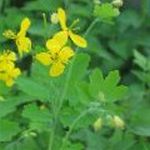| Common Name: |
Tetterwort |
| Other Names: |
Greater celandine, swallow wort |
| Botanical Name: |
Chelidonium majus |
| Genus: |
Chelidonium |
| Family: |
Papaveraceae |
| Cultivation: |
Almost any soil, including clay, in sun or shade. |
| Propagation: |
By seed soen in spring; by division in spring. Chelidonium majus and its variant self-seeds readily. |
| Harvest: |
Flowering plants are cut in summer and used fresh in infusions or tinctures, or as juice. Sap is used fresh; the properties are largely lost on drying. |
| Native Location: |
Temperate and subarctic Eurasia, naturalized in N America. |
| Height: |
30-60cm (1-2ft) |
| Width: |
20-45cm (8-18in) |
| Variations: |
Flore Pleno
Has double flowers.
Var. laciniatum
Has deeply cut leaves.
Laciniatum Flore Pleno
Is smaller than the species, with deeply cut leaves and small, ragged flowers. First recorded at Heidelberg, Germany, c.1590.
Height: 25-38cm (10-15in)
Width: 15-38cm (6-15in). |
| Hardiness: |
Z4-8 |
| Parts Used: |
Whole plant, sap |
| Properties: |
A cleansing, anti-inflammatory herb that improves bile flow, stimulates the uterus and circulatory system, and acts as an anti-spasmodic, diuretic, and laxative. |
| Medicinal Uses: |
Internally for inflammation of the gall bladder and bile duct, jaundice, hepatitis, gout, arthritis, and rheumatism; remittent fevers, smasmodic cough and bronchitis; skin eruptions, ulcers, and cancer (especially of skin and stomach). Excess causes sleepiness, skin irritation, irritant coughing, and difficulty in breathing. Not given to pregnant women. Externally for eye inflammations and cataract, bruises and sprains, warts, ringworm, psoriasis, eczema, and malignant tumors. Also used in Chinese medicine (as bai qu cai) and homeopathy for similar complaints. For use by qualified practitioners only. |
| Warning: |
This herb is subject to legal restrictions in some countries. |
| Bibliography: |
Encyclopedia of Herbs by Deni Brown. Copyright © 1995, 2001 Dorling Kindersley Limited. pg 165
|

